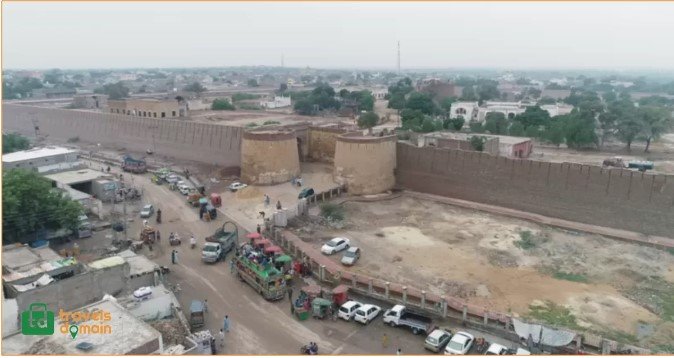Umerkot Sindh: The land of Love, Peace, and Harmony.
Umerkot city is located at a distance of about three hundred kilometers from Karachi. There are also roads from Mirpur Khas, Sanghar, and Thar, while the road from Super Highway to Mirpur Khas and then from there to Umerkot is better.
Before the construction of the road from Karachi to Mithi, the city was the center of important commercial activities and was known as the gateway to Thar.
The fort of Umerkot was considered the key to politics in this region.
On one side is the desert and on the other is the green area inhabited by canal water.
Umerkot Sindh
Umerkot: Birthplace of Emperor Akbar

Mughal emperor Akbar was born in Umerkot. According to historical sources, Humayun settled in Umerkot after retreating from the battle
with Afghan Governor Bihar Sher Khan.
At that time, this poor country king was accompanied by only a few riders and his wife Hameedah Bano.
The uncrowned king distributed “Mushk-e-Nafah” among his companions on the occasion of the joy of his son’s birth and said these words:
“After the death of Humayun, Akbar ascended the throne at the age of 13 and expanded the Mughal Empire many times by force
of the sword this empire lasted till the British occupied the region.”
A monument has been erected at the place of Akbar’s birth in Umerkot, along with a small garden.
Umerkot is a city in Sindh province famous for its bangles and silver jewelry
5 Most Popular Food Streets in Karachi
Love Tale of Umer Marvi:
Umerkot is named after a fort here, where memories of many romantic and heroic characters are buried.
The Rajput Thackeray also ruled Umerkot and later the Soomra dynasty.
Marvi, one of the five heroes or heroines of Sindh Sufi poet Abdul Latif, was born here.
Marvi belonged to the nomadic tribe of Thar. When the then-ruler Omar Soomro heard rumors of her beauty, Marvi was abducted from her village Bhalwa when she came to draw water from a well.
Omar offered marriage to Marvi, which he turned down, after which he was imprisoned.
Various temptations were given but Omar Badshah did not succeed, finally surrendered, and left Marvi as his sister in his village.
Shah Abdul Latif has made this whole story the subject of his poetry and Marvi’s character has become a symbol of patriotism and love for his people.
Museum at Umerkot Fort

There is a museum in the fort of Umerkot, in which in addition to the ancient weapons, there are Munjik shells that were used to hit the
walls of the forts, and jewelry used in the region.
Due to the birthplace of King Akbar, books and documents written in Persian by the then Ministry, including the Akbari Constitution, are
also available for display here.
Among them are some sacred books of Hindu Dharma which have been translated into Persian.
Mughal Era:

There are also many pictures of the Mughal court including Humayun, Hamida Begum, and Akbar. There are also statues of Jains
that were excavated from the ground during the construction of a road in Vera Wah, Thar.
Cannons are also mounted on the ramparts of the fort, and in the middle is a pole, which some people believe was used to hang people,
from where the whole city can be easily seen.
Above the entrance of the fort, there is a mark of a horseshoe. According to local tradition, when Rana Ratan Singh was hanged, his horse jumped.
During this time, one of his feet hit the wall of the fort and became the character of this story.
Rana Ratan Singh had refused to pay taxes to the British government and fought with them after which he was
arrested and hanged.
Religious Harmony

Religious harmony is still evident in the birthplace of Emperor Akbar, who laid the foundation for religious harmony.
There are temples and mosques side by side, the Hindu-Muslim population is almost equal and the two attend each other’s joys
and sorrows as well as festivals.
Near the city, there is an ancient temple of Shiva Mahadev which is visited by a festival every year and the organizers and
helpers include Muslims.
Also nearby is the town of Sufi Faqir, the shrine of Sufi Sadiq, who belonged to the resistance movement of Sufi Shah Inayat.
In addition, there is a mausoleum of Pir Pithoro in the city of Pithoro, which has a large number of devotees of the Hindu community.
Umerkot Bazaar and Bangles:
Umerkot Bazaar is one of the oldest bazaars in Sindh. Leaf handcuffs are still made here and some shopkeepers make traditional women’s bangles.
They are worn wide from the wrists to the arms. The arms of the dance girl sculpture found at Moenjo Daro also look as wide as they
used to be made of ivory or animal bones but now they are made of fiberglass.
Earlier it was used by women of both Muslim and Hindu religions but now it is restricted to Muslim families.
Silver ornaments are sold more here than gold. Hindu tribes, according to their tradition, give silver ornaments as dowry.
The design of each tribe is also different.
Green and Desert
The desert area also starts with the city of Umerkot. On one side there are green fields and on the other side, there is a series of dunes.
The train bound for India passes through various cities of Umerkot district and crosses the border across Khokhra. This is the ancient route.
At the time of the partition of the subcontinent, several families including Mehdi Hassan, Mushtaq Ahmed Yousifi, and Dr. Mubarak Ali had
crossed the border and entered Pakistan.




4 Comments